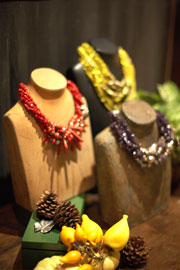|
A Short History of Beads
In the 1530's glass factories were founded in the Netherlands and Bohemia. Venetian glass makers escaped to the new world powerhouse as Venice was losing its world dominance to Spain and Portugal. The Dutch were sending ships to the East for spices which were paid with glass beads. The Portuguese had established trade relations in Africa a 100 years earlier and West Africa's gold was exchanged for Bodom beads made of ground glass. Each bead was worth its weight in gold! Still today the locals claim the beads are magical and grow in the desert sands, where they are frequently found. European collectors are now buying these beads back, at a high price, and they are once again, traded.
 Most modern glass bead manufacturers are in China, Czech Republic, Italy, Japan and Korea.
Semi precious stone beads are made in China, India, Brazil and Sri Lanka. This is very time consuming work, that requires skill and a good eye for detail. South African stones, even diamonds, are often sent to India for cutting, drilling and polishing and then shipped back. They say that the most expensive part of a stone bead is the hole. With modern machines this is gradually changing, and China's opening to the West has caused a drastic slump in the price of faceted stones and pearls. Chinese fresh water pearls are now very affordable and their quality is excellent. When travelling around Shanghai, one can see that every fresh water pond is reserved for pearl cultivation. Most modern glass bead manufacturers are in China, Czech Republic, Italy, Japan and Korea.
Semi precious stone beads are made in China, India, Brazil and Sri Lanka. This is very time consuming work, that requires skill and a good eye for detail. South African stones, even diamonds, are often sent to India for cutting, drilling and polishing and then shipped back. They say that the most expensive part of a stone bead is the hole. With modern machines this is gradually changing, and China's opening to the West has caused a drastic slump in the price of faceted stones and pearls. Chinese fresh water pearls are now very affordable and their quality is excellent. When travelling around Shanghai, one can see that every fresh water pond is reserved for pearl cultivation.
In the old days the Chinese believed pearls to be tears of the dragon and gave the wearer perfect teeth and shiny hair. Pearls became fashionable in the Renaissance Period when Italian painters saw how flattering the contrast of a shiny pearl was against a model's neck. Painters were the fashion gurus of the day! This was the first time in history when jewellery was worn just for the beauty of it. Soon the fashion changed and jewellery was, once again, used to show off riches and to confirm one's status in society.
|